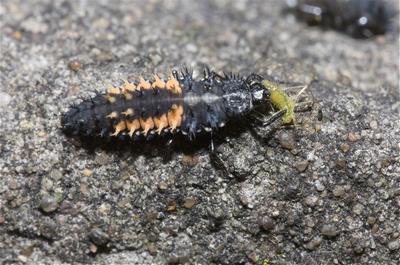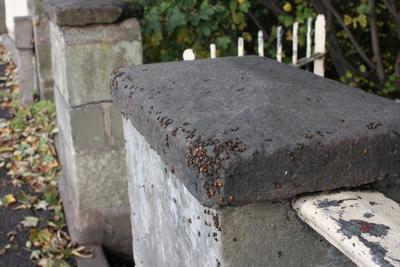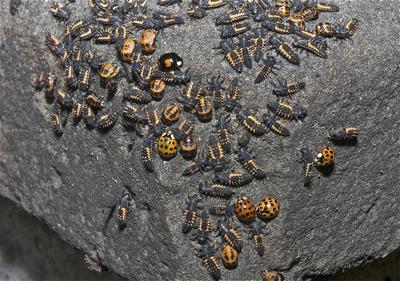 |
Harlequin ladybird consuming an aphid |
Worcestershire Record No. 27 November 2009 p. 21
Harry Green
The Harlequin Ladybird arrived in Britain in 2004 and soon started to spread throughout the country. In May 2005 it was found in Stourbridge, in Old Worcestershire VC37, and other records soon followed and it has now been recorded in locations scattered over the whole of Worcestershire. We have encouraged people to send records to the WBRC so we could track the spread throughout the county but even amongst avid recorders “recording fatigue” develops into “Oh, another one, somebody must have recorded it here before” when they probably haven’t done so! So if you do have records from the last few years please send the in with the usual data: species, date of record, grid reference, place name, your name and contact details. Hopefully we can then build up a picture of the spread and consolidation of the species in the county.
From September 2009 one striking feature of note is that Harlequin Ladybirds are appearing in swarms and we should very much like records of these. For example at the end of August I saw perhaps one hundred crawling over a wooden park seat in Pershore and the phenomenon seems to have increased since then. The Pershore ladybirds were beneath lime trees and they may well have been feasting on aphids in the trees above the bench. Pride of place goes to Rosemary Winnall’s report from Bewdley where, on the 20th October, she found many larvae, pupae and adults on a wall. She wrote:
I've been down to Bewdley this morning (22nd October 2009) to try to count the Harlequin Ladybirds on the pillars and railings near the bridge. I could only access the side along the pavement and my counts will be the very basic minimum! Larvae – 1317, occupied pupae – 305, adults – 182, total – 1804. This wall is under the sycamore trees and there were plenty of aphids on the stonework - at least two species – fallen from the sycamores. Many of the sycamore leaves are falling off, so the aphids are obviously moving around. I was particularly looking for other insects present and found one Pine Ladybird, two 2-Spot Ladybirds, one tiny shieldbug nymph and two individual larvae of two different species of hoverfly. There were plenty of aphids caught in spiders webs underneath, but no ladybirds”.
 |
Harlequin ladybird consuming an aphid |
On the 1st November 2009 I received a report of “a great black swarm” of Harlequin Ladybirds inside Little Comberton church tower near the bell-ringing chamber. I’ve heard of people ringing a handbell to get a swarm of bees to settle but one wonders how ladybirds will settle in a belfry!
It is well-known that Harlequin Ladybirds enter houses in autumn in search of hibernating sites so if you get invaded please send in the record. Be sure your identification is correct of course because 2-spot Ladybirds often for large hibernating groups in houses and the 7-spot ladybird which is about the same size as the Harlequin also frequently comes indoors. Pictures and information have been published in earlier issues of Worcestershire Record and appear on the our web site www.wbrc.org.uk. An internet search will reveal a great deal of information!
There has been considerable worry that Harlequin Ladybirds will attack and eat other insects and their larvae if they are short of aphid food although more recently there have been suggestions that the species will settle simply as another aphid predator amongst our native insects.
 |
Harlequin ladybirds in Bewdley - |
|
Harlequin ladybirds in Bewdley - |
 |
References:
| GREEN H. 2004 The Lily Beetle Lilioceris lilii and the harlequin ladybird Harmonia axyridis: two species worth looking out for. Worcestershire Record 17:26-27. | |
| GREEN H. 2007 The Harlequin Ladybird (Harmonia axyridis) Worcestershire Record 21:10-11. | |
| GREEN H. 2007. 2007 – The year of the Harlequin in Worcestershire. Worcestershire Record 22:31 | |
| GREEN H. 2007. The Harlequin Ladybird Harmonia axyridis. Worcestershire Record 23:5. | |
| ROY H, ROWLAND F, BROWN P, WARE R, & MAJERUS M. 2005. Ecology of the Harlequin Ladybird – a new invasive species. British Wildlife 16, no. 6, pages 403-407 |
| WBRC Home | Worcs Record Listing by Issue | Worcs Record Listing by Subject |